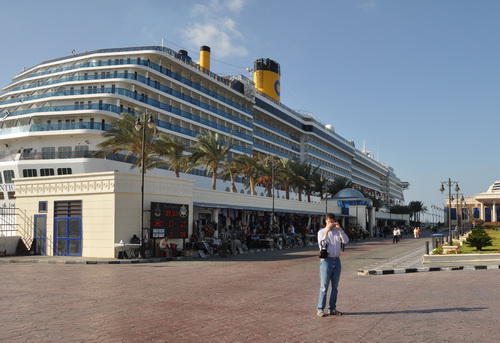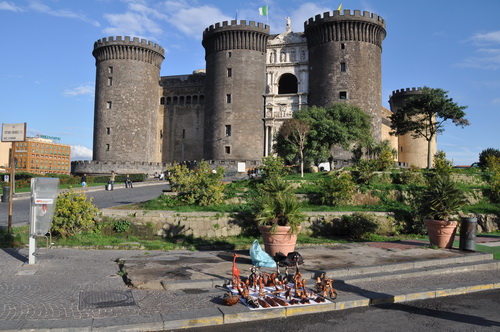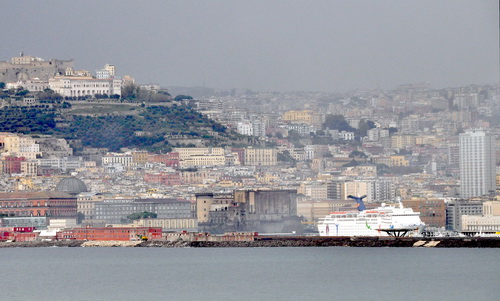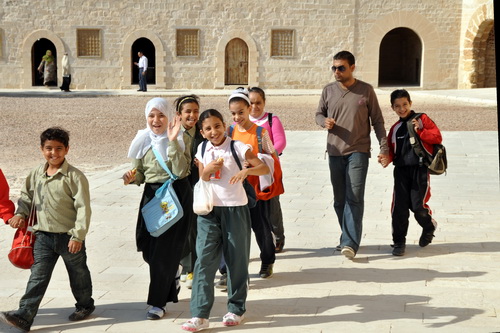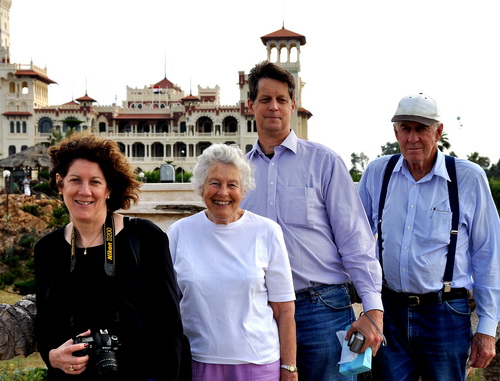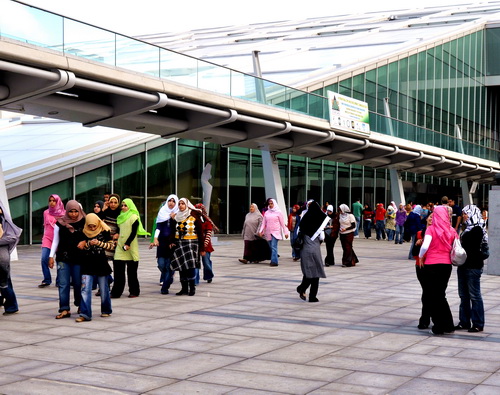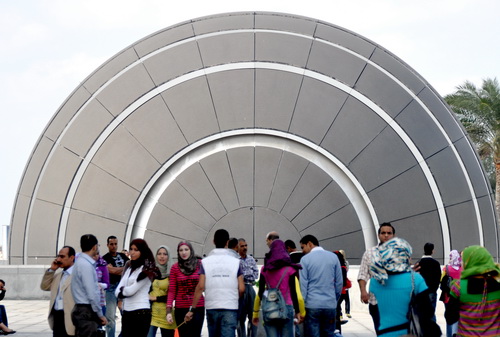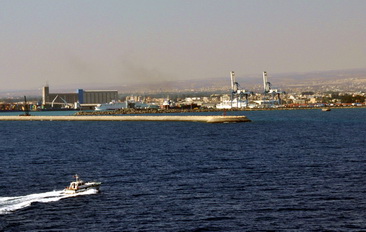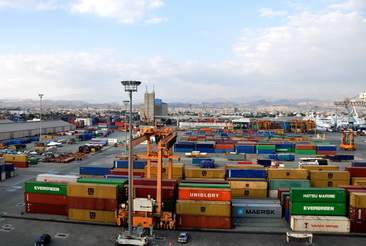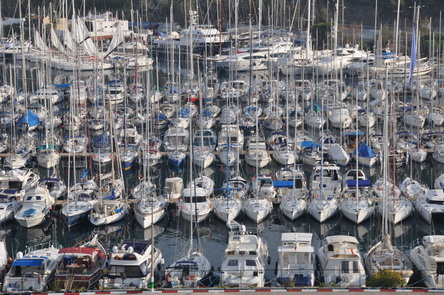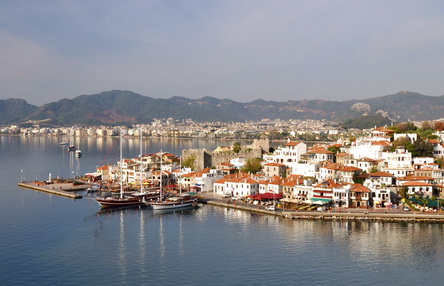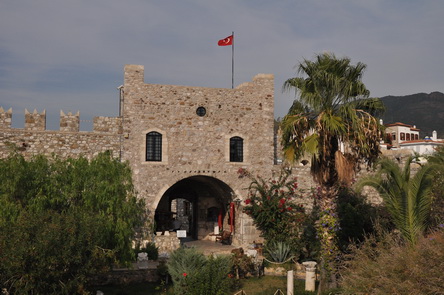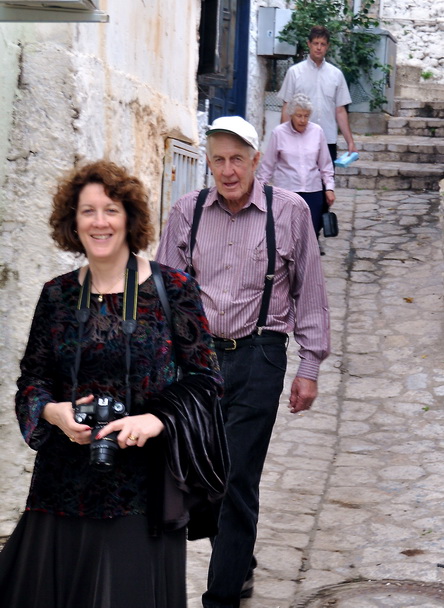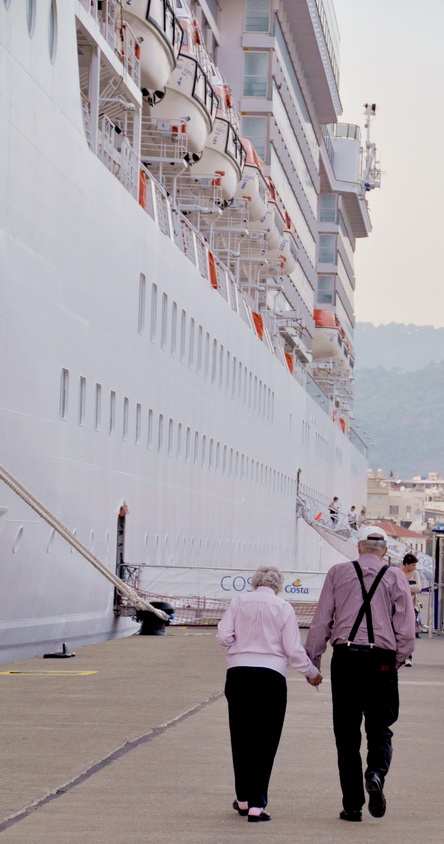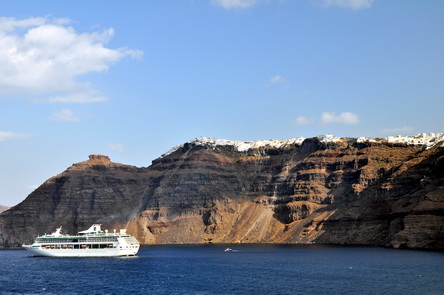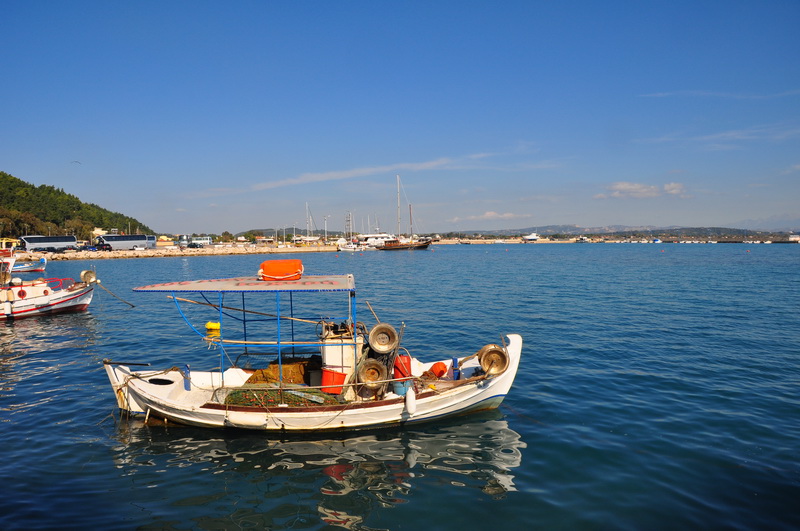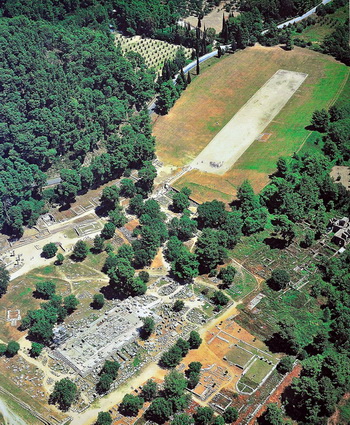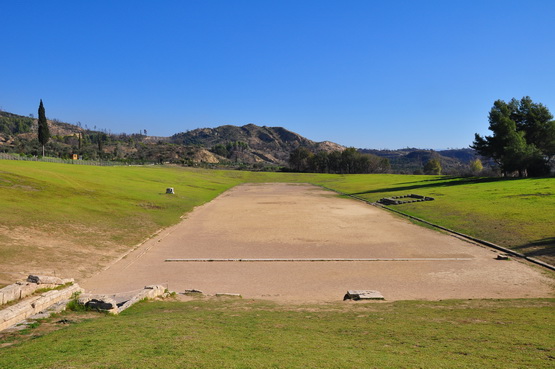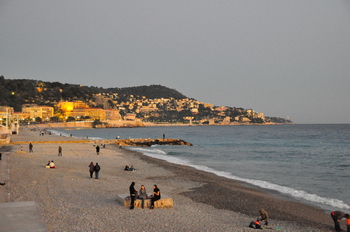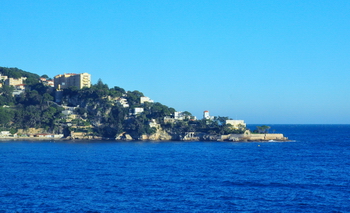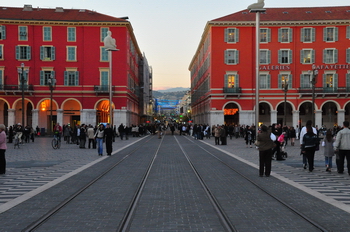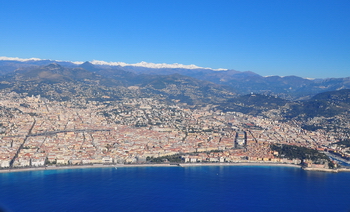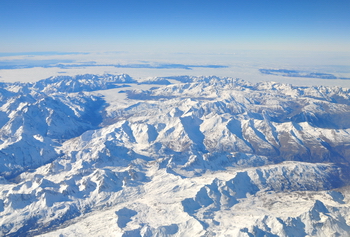Eastern Mediterranean MacMania Cruise, Nov. 2008
by Ron Anderson <rea@umn.edu>
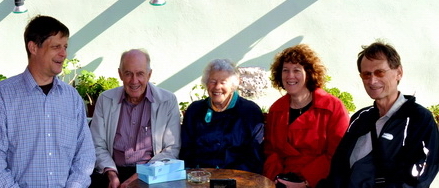 |
|---|
Our trip began on election eve as we met Nancy's parents (Norman and Dorothy) at the Minneapolis airport. Together we arrived the next day in Nice via Amsterdam as the rain poured down. During the night we watched the election returns on CNN waking up to an Obama victory. For the remainder of the trip our only contact with the world news was the BBC and an occasional newspaper. From this exposure, plus an occasional comment by Europeans, our impression is that much of the world is very happy with the President-elect. Almost every taxi driver and waiter, when they found out we were Americans, said "Obama" and gave a thumbs up sign.
Obama's speech election night made it obvious that the white house will take on a new mentality, one driven by humanitarian rather than self-centered values. Obama emphasizes unity rather than personal freedom; looking out for each other rather than oneself. At least that is what his speech promised. His cabinet choices since then have put a bit of haze over the feelings of hope that he generated around the world.
Ralph (Nancy's brother) met us at the ship in Savona, which is something like a suburb of Genoa, Italy. He took the train directly from where he lives in Germany.The rest of us took a 2-hour train ride from Nice to Savona. (There is more on Nice and Savona toward the end of this story.)
The MacMania Costa Cruise with Family
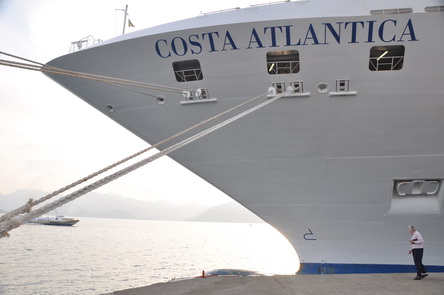 |
Dorothy Walking at the Bow of our Ship |
Our ship for this cruise was the Costa Atlantica, one of many built by the Italian Costa family but purchased by the American Carnival Line. About 90% of the passengers spoke Italian. The average age seemed to be about 55 but there were hundreds of young people in their 20s. Their average waist lines seemed to be about half way between the French and the Americans. The ship carried about 2,400 passengers plus about 1,000 staff. The ship has about 13 floors, which are called decks. These two pictures will give you an idea of the size of the ship. In the photo below Ralph, who is 6' 6" tall, stands nearby the ship; only about half of the decks can be seen in the picture.
For the most part the seas were calm, except for a couple of occasions when we had a steady roll. The Captain said that the ship had stabilizers, but the times when the ship rolled during our cruise were not heavy enough to justify using the stabilizers. The size and technology of current passenger ships protect one from sea sickness much better than the ships of the 1950s. I remember at age 10-13 getting sea sick on the Queen Elizabeth and other ships that we sailed across the Atlantic.
About 150 of the 2,500 passengers had signed up for the “MacMania” workshops on technical aspects of the Macintosh, iPhone, and various topics like good Googling. Most MacManians were Americans. Workshops were scheduled for every waking moment when the boat was at sea, except for a little time out for eating. (More about MacMania will be described in the last section of this story.)
As we began the journey the rain and chill continued. By the time we had traveled half way to Africa, the skies cleared and on a few days it was warm enough to sit on deck and soak up a bit of sun.
The typical routine of the trip was to arrive at a port at dawn every day or two. While in port we disembarked for 4 to 14 hours and wandered around the coastal city. Tours were available, but we resisted them so as not to be rushed and to see more of the local culture. On several occasions we arranged out own tours. (You can find the complete chronology of the trip summarized in a table at the bottom of this document.)
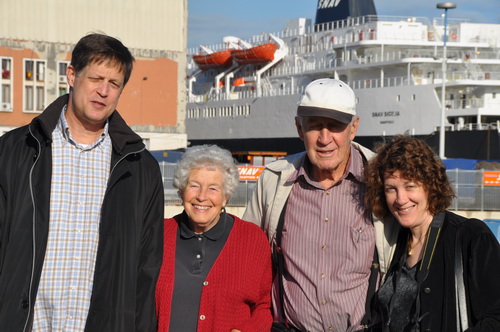 |
Ralph, Dorothy, Norman, and Nancy Enjoying Naples |
The first port was Naples, about half way down the Italian coast. My image of Naples had been that of a romantic city like Florence. Walking around the city close to the port destroyed that image as the crosswalk-free streets were packed with car and truck drivers who largely ignored pedestrians.
Our two highlights in Naples were a leisurely visit to a coffee shop featuring a large variety of locally baked pastries and a tour of the city in an open-air double-decker bus. The bus tour gave us a sense of Naples as an old city with dark buildings and narrow streets packed with cars. The most imposing building in the city is the Castel Nuovo, which is another name for dungeon. Built in the 13th century, it served as a massive castle for hundreds of years. Now it serves as a museum. The castle's shape is rather unique: it is square except that the back wall is almost twice as long as the front wall. (See photo below.)
Another major landmark of the city is the Museo Nazionale di San Martino, which used to be a gigantic monastery set on a hill high above the central city. Behind the former monastery is a large fortress. The picture below shows a faint glimpse of these buildings on the top of the hill on the left side of the picture. On the right you can see the cruise ship harbor.If you look carefully you will see the wide diversity in the types of buildings in Naples.
Messina with 300,000 people is the third largest city in Sicily and the closest to Italy geographically. It would be touching Italy were it not for a narrow strip of water. I had always thought of Sicily as being mostly rural and dominated by the Mafia. Well, the first stereotype was destroyed and we saw no evidence of Mafia. Furthermore, we heard that Sicily is working hard to rid the Island of Mafia.
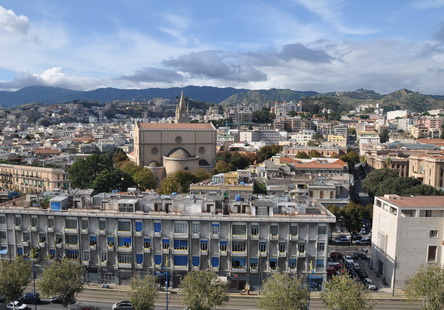 |
Messina, Sicily, showing the City Center around the Cathedral |
Sicily is a largely autonomous region of Italy. Its population is 5 million, but twice that number of Sicilians are scattered across other countries, especially the United States. Its per capita GDP is about two thirds that of Italy, putting it income-wise near the bottom of Western Europe. Nonetheless, Messina appeared to be a very thriving, modern city comparable to typical European cities of its size.
(Incidentally, at the bottom of this document you can find a table with the per capita GDPs for each place we visited.)
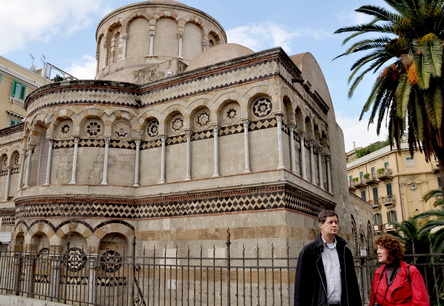 |
Church of the Annunziata, Another Restoration |
The first interesting structure we found was the Church of the Annunziata dei Catalani. As shown in this picture on the right with Ralph and Nancy in the foreground, the edifice has elegant designs built into its walls. First built eight centuries ago, it has been restored several times including after the 1908 earthquake that killed 80,000 people in the city.
The city's principal historic landmark is the Messina Cathedral. Built in the 12th Century, the building contains the remains of Conrad, king of Germany and Sicily in the 13th Century. In the 1908 earthquake the Cathedral, along with the entire city, was pretty much destroyed, but like most of the city, it has been totally rebuilt, this time to be earthquake resilient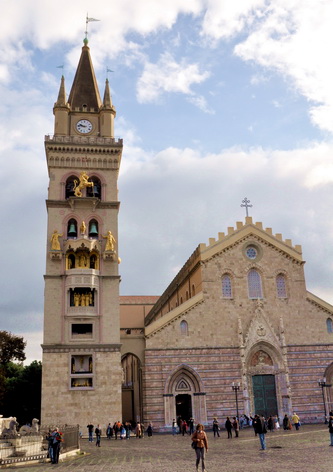
The Cathedral occupies center place in Duomo piazza, which sits in the center of the city. It not only is famous for its eight-century old architecture and artwork, but for its animated figures painted gold that move about at noon every day. Little golden statues move in and out of their windows at noon every day. They are driven by clockwork mechanisms built in 1933, and intended to represent historical as well as religious characters.
Consistent with our tradition of having coffee, tea and pastries at each port, we relaxed at an outdoor cafe next to the Cathedral.
All was not peaceful in Messina. In fact, a loud student demonstration started up at one corner of the Piazza next to our cafe. Several thousand University students marched protest down the streets.. They were demonstrating against a rise in tuition brought on by cuts in funding for education.
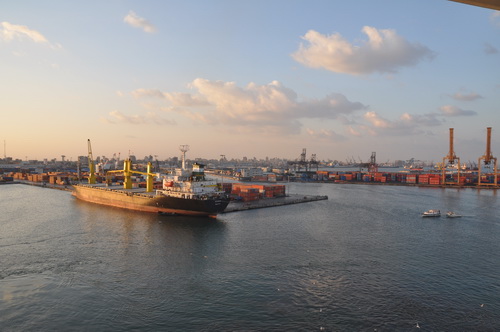 |
|---|
To establish a frame of reference, Alexandria is a city of 7 million people, a bit less than one tenth the population of Egypt. Like most of Egypt it is 90% Sunni Moslem. The per capita GDP is about $3,800, which is about one tenth that of the United States.
Although I remember Egypt from 55 years ago, Alexandria still was a shock to me due mostly to its poverty. Alexandria has been a kingdom within the Greek and Roman empires and remains the most popular European holiday spot in Africa. However, some parts of the city appeared much like I remember Cairo to be 55 years ago.
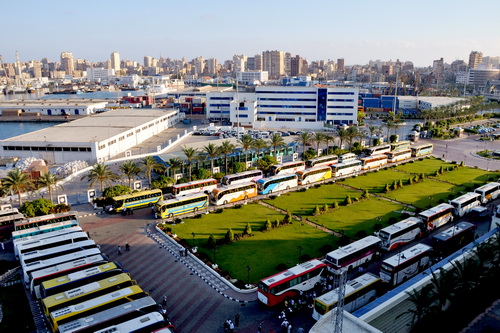 |
This picture shows what the city looked like from the ship as we disembarked. As you can see in the photo, there were at least 50 buses waiting to take passengers on excursions. Almost all of the excursions included a drive through Cairo and a visit to the pyramids of Giza and the famous sphinx.
We decided against an organized trip because they all took at least 12 hours, most of which was spent riding on a bus. We organized a short taxi tour, giving us a few hours of rest on the ship as well.
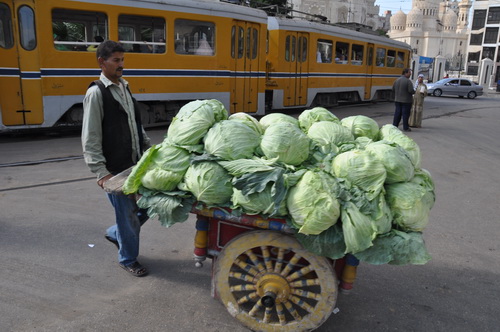
All major streets offer a wild driving experience. People darted within inches of the speeding cars just to cross a street. Pedestrians and drivers constantly played a game of survival amid a chorus of beeping horns. I cannot recall a city with so many drivers banging on their horns. The roads had neatly painted lines for lanes, but drivers totally ignored them. Compared to American drivers, we found French and Italians to be ruthless. Compared to Southern Europeans, Egyptian drivers were perilous.
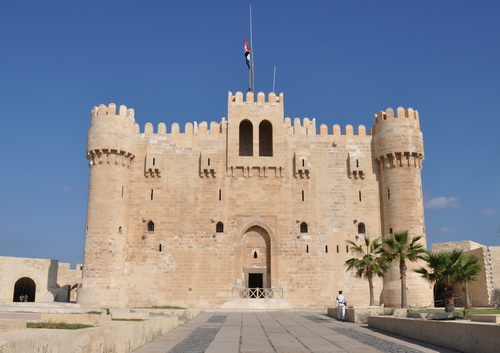
Next we stopped at the largest Islamic mosque in Alexandria, the Al-Mursi Abu al Abbas Mosque. We settled for just enjoying the beauty of the exterior because the women in our group were told they had to take some undefined rear entrance and the men were required to take off their shoes.
As we left a bunch of stray cats meandered across the road. We saw lots of stray cats but no stray dogs on the streets. Perhaps Egypt literally is a dog eat dog world.
The next stop took us several miles down the coast to what our driver said is the most important site in all of Alexandria, the Montaza palace and gardens. You can see the palace behind the four Kehmeiers below.
We settled for only a short stroll in the gardens because visitors, except for heads of state, are no longer welcome inside the palace. The desert gardens are creative and attractive though not particularly colorful. This fancy summer palace was built by King Faruk, the last king of Egypt. He was forced out of office and the country by Nasser and his military colleagues in 1954.
Other than side trips to a coffee shop, a pharmacy, the post office, a bank, and an Internet shop, our last destination was the New Alexandria Library. The very first Alexandria “mother library” was established in 311 B.C. Euclid and many other famous thinkers were influenced by this library, but it was burned down less than 300 years later. The new library is famous for is modern architecture as well as a wealth of holdings on archaeology and hieroglyphs. It seems to be the number one library on Middle East subjects, but many people come just to see the buildings. You can see it below.
Notice the large number of both young men and women in this picture and the next. A woman without a head scarf is rare, as is one with a face-covering burka, but we ran across both occasionally. Across the street is a university and we saw hundreds of women in bright colors and semi-modern types of dress walking to and from classes. They certainly disproved the stereotype of most Arab or Moslem women as uneducated.
The building is shaped like a door wedge. Above is the main part of the library with resources and work areas.
The building shaped like a ball on the right is the library's planetarium.
While some sectors of Alexandria have not changed in 50 or more years, others have been rebuilt with classy, modern style and big money. Social change comes slowly, like any other society, but change probably is most evident in the young, who are influenced in little ways, despite their relatively conservative dress and their formal prayers five times a day.
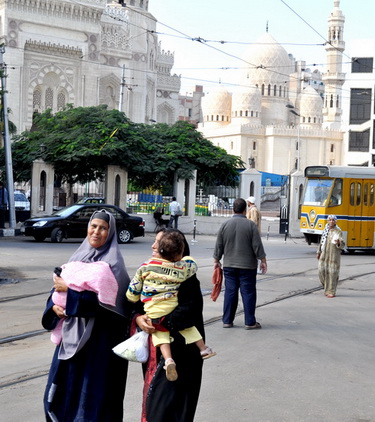 |
Six years ago we spent at least a week in Morocco. Egypt and Morocco seem to have a lot in common with respect to their paths toward modernization. But Morocco has close ties to France, while Egypt has close links to the UK and the USA. Egypt has the disadvantage of being a lot further from its mentoring nations than does Morocco. It also has the political tensions of Palestine, Israel and Sudan on its borders.
In 1953 I remember being impressed by the Cairo zoo and bottled soft drinks. It was the first time I had seen Coca Cola for sale and my first zoo. Now it is no longer a monarchy, but the gap between the rich and poor is so great that it keeps the country unstable, especially with the population tripling in 50 years since I was there. At least the per capita GDP is twice that of neighboring Sudan, so overall Egypt is slowly improving.
Limassol is on the southern side of Cypress, which is the Greek-oriented side. Much of the northern side of the island leans toward Turkey. Due to the ongoing tension between the two parts of Cyprus, the UN controls a strip of land between the two territories.
About four years ago Nancy and I came to Cyprus for a meeting and during that time we walked across this UN-controlled border. It reminded me of walking from Arab-controlled Jerusalem into Israel in 1950 during my family visit to the "holy land." In both instances, barbed wire absorbed my attention.
In our previous visit to Cyprus, Nancy and I visited Limassol, so we had already seen some of the city's highlights. Both times we found the waterfront of the central city very interesting to walk along. A variety of outdoor sculptures adorn the park-like waterfront.
Our cruise ship docked in a container shipping area, and we found it fascinating to watch the machinery moving and lifting the huge containers in and out of container-carrying freighters. It should be clear from this picture on the right that Limassol is a big, busy port.
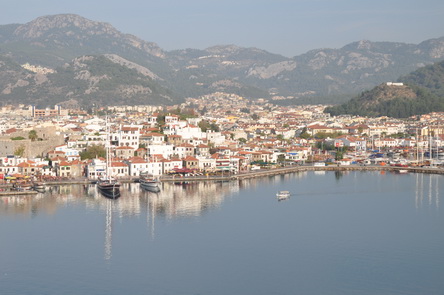 |
In Southwest Turkey just where the Aegean Sea meets the Mediterranean runs an inlet north to the town of Marmaris. They claim it to be the largest natural harbor in the world, and hundreds, if not thousands, of sailboats are moored in Marmaris.
It was not the size of the harbor that caught my eye, but the beauty of it all. In the early morning, color and shadows of the mostly white colored buildings and symmetric rows of sailboats kept me clicking my camera nonstop. I think you will agree with me from the sample photos that this is an extremely picturesque part of the world.
The town looks deceptively large because most houses line the water and they have many more houses than the winter population of 15,000. During the summer the population jumps up to 75,000.
Other than the marina and its thousands of boats, the main attraction of the town is the Marmaris Castle Museum. The museum resides in a fortress in the old section of Marmaris and stands gallantly above most of the nearby houses.
The Castle (on the left) complete with fortress walls and canons was built during the Byzantine period by an Ottoman Sultan in the early 1500s. Much of it was destroyed and rebuilt several times since then, the most recent restoration being just over 25 years ago. Some of the original stones were used in the current restoration. Probably the best part of the Castle is the magnificent view in three directions, all of them over the red tile roofs of the houses. In the photo below you can see this view with our ship in the background.
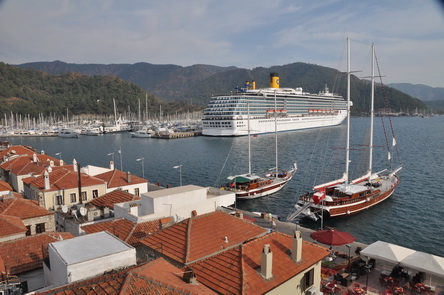 |
Getting to the castle was a winding trek up and down narrow alleys between houses and an occasional shop. From the sea one sees mostly 3 to 5 story buildings, but hidden behind these vacation residences are the tiny homes of the local people sandwiched together into little neighborhoods.
On the left is a picture of the Kehmeier family navigating through these narrow alleys in the city.
In the picture below you can see the Kehmeier family resting up at a seaside cafe.
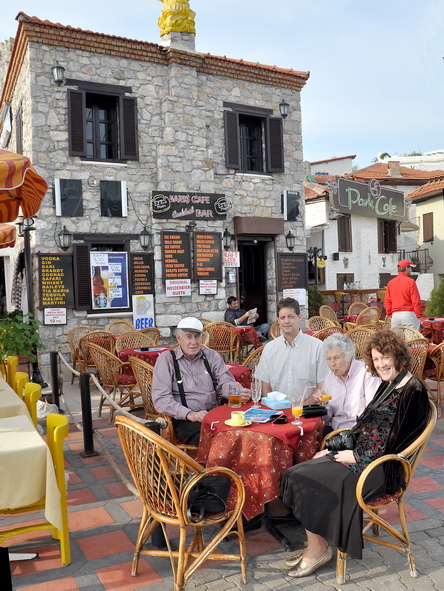 |
Getting to and from the ship was an escapade. The five of us squeezed into a little European taxi for both directions. Keeping in mind that three of us were over 6 feet tall, we squished four into the back seat each time. Returning to the ship also required filling out a long questionnaire for the Turkish tourism bureau. Being conscientious Americans we gave an extra 15 minutes of our time free to the Turkish government. Of course we should not complain about giving a little time and information to Turkey. After all the average income of Americans is about five times that of the Turks.
Norman & Dorothy Walking Back to the Ship
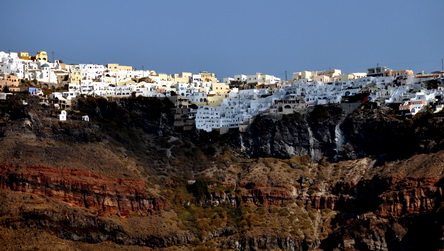
Paradoxically, one of the most popular Greek vacation spots lies closer to Turkey than to Greece. If you know the Greek Islands, you may know Santorini as the place where bright, white houses rest atop the rims of a volcanic crater. I had seen many appealing pictures of Santorini in magazines and books, but I was totally unprepared for the appearance of Santorini as our ship arrived and anchored in the middle of the sunken crater. In every direction we looked stood huge, barren mountains colored dark brown. From a moment when we first arrived in the middle of the crater, I thought the white crust on the crest of the mountains was snow. Look at the picture on the left above; doesn't it look like a snow capped mountain? It is actually a collection of white washed houses in the town of Oia in northern Santorini. If you get close, like the picture on the right, the crest of snow becomes a village..
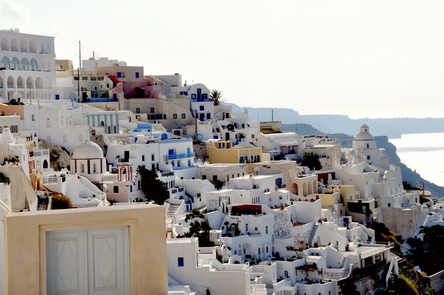 |
The Town of Fira in the Santorini Islands |
If you look at a map of Santorini, you will see one big crescent-shaped island about 15 miles long and four little islands. The main Island is big enough for an airport and a dozen villages. Of course a map does not show that the shores of each island are actually steep cliffs. The only way to get to the villages is by plane or ship. If you go by ship, you must climb the cliff by foot or donkey. However, in the northern part of the big island is a cable car to save time and energy, and in the southern part is a road going up the mountain with hair-pin turns.
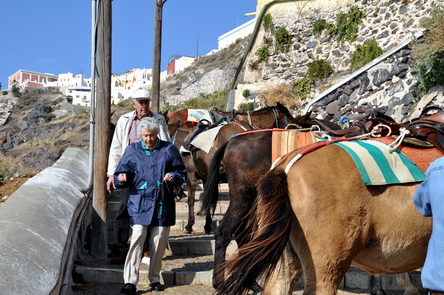
Santorini may be part of Greece, but its average annual income (less than $4,000) is less than one fourth that of the country over all. The local people have learned to live simple lives requiring little money. That may be one of the factors underlying Santorini's attraction to many thousands of visitors every year.
Santorini is what remains from a series of many volcanic explosions. A large eruption about 2000 BC destroyed a village in southern region of Santorini. In the last few years archeologists have unearthed from the rocky ash a complete village in Akrotiri dated about 40 centuries ago. Some believe it is the remains of the lost city of Atlantis, but most likely the Atlantis city was created in the mind of Aristotle. Unfortunately we were not able to see the unearthed village on this trip.
One would think that the Santorini crater would be fixed and permanent, but there have been ten eruptions even in the last 500 years. These small eruptions have left new islands behind and reshaped existing ones. Despite such life-threatening risks, people still choose to build their homes on the rocky cliffs. Not only that, but many artists and others vacation in Santorini for months at a time. Cruise visitors like us visit Santorini unaware of its vulnerable history.
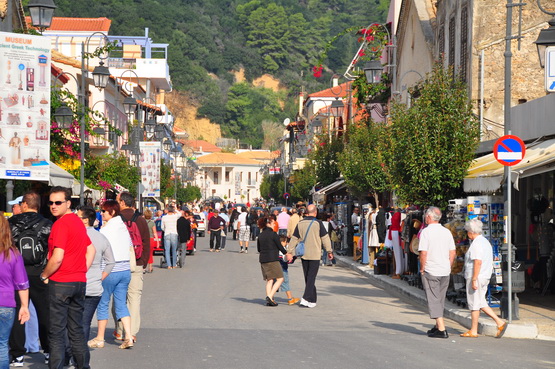
Katakolon also has a row a delightful row of restaurants on the waterfront. Some of the local people of whom there are less than 2,000 work in the fishing industry. Below is a photo of one of their fishing boats moored just in front of the restaurants. The picture was taken about noon, which seemed to add to the clarity of the colors.
Olympia (both the archeological site and the delightful village) are located about 15 miles away from the port. The taxi trip to Olympia took us through colorful farm country and rural roads with shops of all kinds. For about half of the way we drove the main road from Athens, which is about a three hour drive away. Busloads of students as well as tourists come down from Athens to visit the ruins of Olympia.
The ruins associated with the Olympic Games include the Stadium, the Temple of Zeus, and about 30 additional sets of buildings, an aerial view of which is given on the right.. Although little is left of the Stadium, it leaves a powerful impression to those that know that it once held 45,000 men (women were not allowed) as they watched the naked athletes compete.
You can see in the pictures on the right and below, that at the center is a field of rock and dirt surrounded by grassy knolls. These grassy areas once held seats for nearly 50,000 onlookers. In between the field and the spectator areas excavators found a rock conduit, which apparently was kept filled with water for the spectators to drink.
Apparently the Games began in earnest during the 8th century BC. The Games continued every four years for nearly 1,200 years. The Olympic Games resumed in 1896, and in 1936 the tradition of lighting the Olympic Flame as a symbol of peace, friendship and brotherhood was initiated. The ceremony was held in front of the Temple of Hera, and although the Temple is in ruins today, this summer's Olympic Games began with a flame-lighting ceremony in front of the Temple. This summer's flamed torch was kept burning as it traveled around the world, carried by Olympic contestants of almost every country.
Between the Temple of Hera and the Stadium rest the Temple of Zeus and th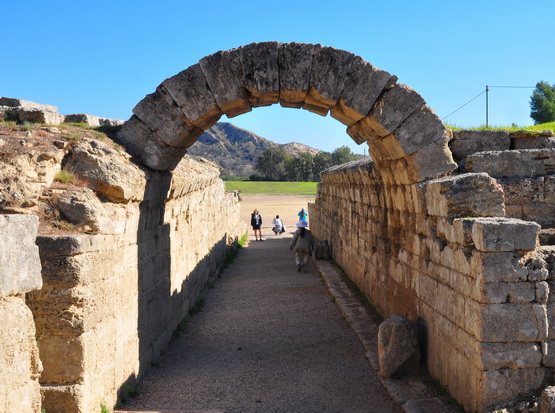
The Temple of Zeus was the building where the winners received their prizes. Around the perimeter of this large building were statues of winners, heroes, and gods. In the center was a throne for the mythic Zeus.
The Temple of Zeus in particular, but the whole Olympic area as well, was considered sacred by the Greeks. During the games, Greece and the surrounding countries agreed not to engage in battle.
Olympia leaves a lasting impression upon its visitors. It is hard not to come away with respect for the ancient traditions. The Olympic Games were associated with the ideals of noble rivalry and peace. They helped unify the country, much the way that the Olympic Games even now help to bring the world community together in cooperation, ironically in order to compete.
From Savona, Italy to Nice, France
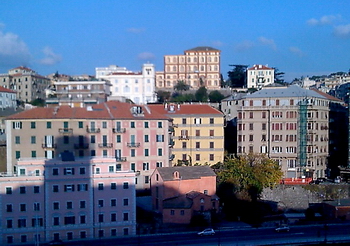
Our ship returned to the Savona harbor just after dawn. The blue skies made the end of our cruise more bearable. On the right is a picture of Savona captured by my iPhone. Note the shadow on the building. It was the shadow of our ship that darkened the small town. The buildings are typical of this area, which is called the Italian Riviera.
Our train left for Nice (pronounced niece) only a few hours after disembarkation so we didn't have time to go to Savona "big sister" city, Genoa. About 25 miles southeast, Genoa is Italy's largest shipping port. It is a city of 600,000 and a rich historical tradition.
After a 2-hour brunch in a genuine Italian restaurant, we said goodbye to Ralph and boarded the train to Nice. The 2.5-hour trip is one of the most picturesque in the world. The train track remains close to the seashore of the Italian Riviera and then the French Riviera. Below is a picture taken from the train window of a typical scene on the French Riviera. We arrived in Nice in time to walk to the seashore just after the sun had set. it was cold but many people were still out on the beach enjoying the fading orange colors of the sunset.
The picture above captures the beach colors at sunset looking south from the center of Nice. The photo on the on the left with the red buildings was taken a few blocks away about the same time of the evening. The red buildings, with a light rail and pedestrian walkway in between, constitute Place Massena, the main square of the city. Located between the old town and the central business district, it has a large enough open area for summer concerts and various celebrations. We were most impressed by the statues, lights, and colors.
According to archeologists, Nice is one of the oldest human settlements in the world. The population is only 350,000, and many of those are elderly. But Nice has a thriving tourist business and immigrants are helping to keep the population growing. It is the fifth largest city in France. Nice is a great place to visit but hotels are not cheap.
The next day we flew home from Nice by way of Amsterdam. On the right is a picture I captured through the airplane window of the most dense portion of Nice. Notice the French Alps in the distance.
On the way to Amsterdam we actually flew over the French Alps, which you can see pictured on the left. For many years I have tried to capture snow covered mountains through an airplace window. I have tried several times in Alaska and Colorado. This is probably my best so far. What is especially interesting about the French and Swiss Alps is that people actually live in the meadows in between mountain ranges. Alaska has glaciers between mountain ranges and Colorado has freeways. The Alps are what you might call people friendly. It was a great way to end the trip.
Reflections on the MacMania8 Experience
MacMania is a cruise package organized by Insight Cruises. As you might expect, ours was the eighth one. Next year it will be in China. About 175 people had signed up for MacMania, which means that they could attend 90 minute workshops and lectures on various subjects related to Macintosh computers. Typical sessions were "iPhone: the Missing Manual," Extreme Googling, "iPhoto '08," and "Organizing your digital memories." A few were more theoretical but most were very practical and targeted toward beginners and intermediate-level expertise. Some of the speakers and instructors were very well known; and some were excellent speakers.
Sessions were scheduled whenever we were at sea, beginning at 8:30 in the morning to 8:30 at night. Sometimes 2 sessions were scheduled concurrently, so you had to chose one or the other. There were a total of about 30 sessions.
The Kehmeiers had selected the early dinner time slot of about 6:30. Sometimes Nancy and I missed the sessions to go to formal dinner, and sometimes we went to the sessions and just got a slice of pizza afterwards.
I tried to learn how to be a Macintosh person but I still feel like a neophyte. The best part of learning all of the quirks and tricks of new software is the way it tests my patience and builds character. The week before the trip with Nancy's help I made a couple of little movies on the Macintosh for the Bushaway Sesquicentennial. On the trip I took a short workshop on iMovie, but I still feel like a first grader with this technology. I have been using PC software for 3 decades, so it is hard for me to change over, especially because there is so much new PC software to learn. I must say that I did learn a lot about iPhone and Googling at MacMania sessions.
Reflections on the Cruise Experience
Most of our cruise experiences were novel and fun but on some days I had fantasies of relaxing at home where there is room to stretch out, bathtubs in which to relax, and rapid access to the Internet. Internet access on cruise ships tends to be outrageously expensive, very constrained, and very slow. On this trip we paid an extra fee for wireless access but it was available only in a few lounges and most of the time it didn't work. When it did work, it was very slow. Too much of our time went into just waiting for Internet responses, but at least we had some access most days.
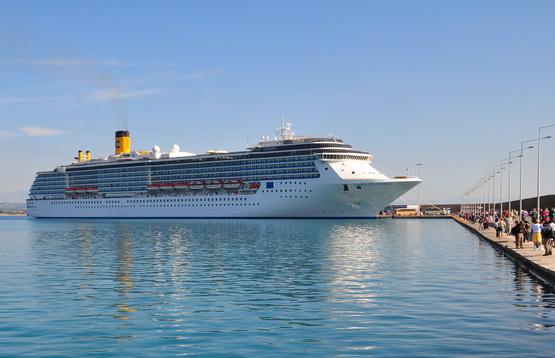
Given that the ship provides continuously available food, my waist line expanded during the 9-day cruise. Actually I only gain 5 lbs, but after returning home I found myself getting a wee bit hungry and then automatically thinking about running up to the restaurant for tea and cake. In addition to the three meals where it was "all you can eat" of dozens of different foods, pizza was served all day until midnight and coffee, tea, and little cakes were available almost any time. Of course, everything was free including ice cream. In that environment it is very easy to fall into the rut of eating three big meals a day and snacks between them, to help increase the consumption of coffee or tea to help reduce the symptoms of jet lag. It take a lot of conscious planning (will power, if you will) to keep from over eating on a cruise, I think.
Some, especially those who like to talk to strangers, choose cruises over hotels. If you like to eat dinner with strangers, then a cruise boat is for you. But if you don't like to bump into other people every time you turn around while filling your cup with water or coffee, then maybe a cruise is not for you. Actually, some cruises allow more privacy than others. Also, some are considerably less crowded than others. This cruise was slightly on the crowded side, but events and lines were fairly well controlled.
During this cruise most of our group acquired serious cases of the flu and could not enjoy the trip as they otherwise might have. Being “imprisoned” on the ship, we were not able to go to our usual medical care facility for treatment, however in several ports we sought out pharmacies for cough suppressants. On top of the flu, one family member could not sleep, which prolonged the suffering even longer. Contagious diseases create problems for any cruise-like environment. I'm sure there were many more people coughing at the end of our cruise than at the beginning.
The most mentally healthy attitude toward such calamities is to view them as blessings rather than curses. After all, every shared misfortune gives the members of a community opportunities to empathize and help those who are suffering.
Despite these minor inconveniences, we had a wonderful cruise and were lucky to share the exploratory experiences of seven ports of call in addition to the departing port of Savona. We encountered little bits of interesting culture in five separate countries and were able to make interesting comparisons despite the brevity of the visits.
In thinking about our future travels, I have been reflecting on the cruise and wondering if we will ever opt for one again. If your aim is to see the world, then a cruise helps you see lots of places. But if your goal is to understand the world, then it doesn't generally work well. Staying in a port for only 6 hours can only give one a superficial understanding of one or two things about the culture and maybe a few details about the history and geography.
There is nothing like living in a place to aid understanding, even if living in hotels. I like to visit places where the local people mistake me for being one of them. Of course that doesn't happen in Asia and Africa.
Ralph reminded me that a cruise of the type we took is a romantic experience to be treasured. In some ways the cruise ship is like a playhouse within which you can be removed from the harshness of the outer world. Sharing this experience with good friends or family magnifies the fun.
We discovered that a ten-day family cruise reinforces family intimacy and chases loneliness away. In cruising together we also learn more about each other and ourselves as a member of the family group. Despite arguments and irritations, we learned more about each other and came to appreciate each other more.
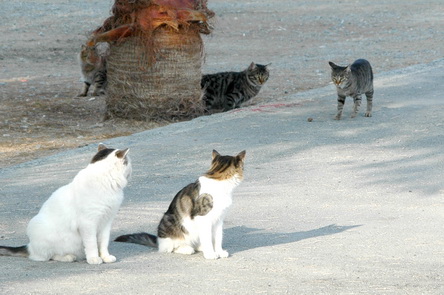 |
|---|
This may be the last cruise we ever take, but like someone said, “after every cruise I say this is the last cruise I will take.” The conveniences of a cruise and the exotic destinations can be quite compelling. But I still think we will plan most of our trips ourselves rather than let the cruise leaders do so.
To get the most from a cruise, one should take advantage of the free time by relaxing and resting. Nancy and I violated that principle by attending technical seminars on Macintosh, iPhone, and other computer technology. We learned a lot from the sessions, but it didn't give us any time to lie on deck chairs and read a good book. The weather on this trip only allowed deck chair time for two or three of the ten days. But there are many nooks and crannies on the ship in which to enjoy quiet time. So, unless you enjoy unlimited or nonstop eating, cruises are not necessarily the best way to travel.
One of the benefits of a cruise ship is just the chance to explore a whole new environment to see how it is all put together. Again the playhouse metaphor is appropriate. The people give one a chance to explore too. It is remarkable that a single ship can hold the equivalent of a town of 3,400 people. And like a small town you can slowly get to know your neighbors. We got to meet some interesting people, but mostly it was a chance to experience some interesting places, and most of all, it was just a fun time. It was sad for the trip end.
Appendix:
Countries |
Per Capita GDP |
Italy |
27,900 |
Greece |
22,800 |
Cypress |
22,700 |
Sicily |
18,800 |
Turkey |
7,900 |
Santorini |
4,900 |
Egypt |
3,800 |
